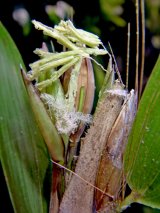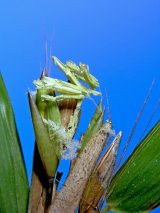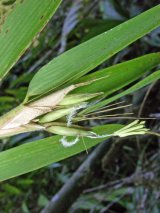 |
QUICK SEARCH
MO PROJECTS:
Africa
Asia/Pacific
Mesoamerica
North America
South America
General Taxonomy
Photo Essays
Training in Latin
America
MO RESEARCH:
Wm. L. Brown Center
Bryology
GIS
Graduate Studies
Research Experiences
for Undergraduates
Imaging Lab
Library
MBG Press
Publications
Climate Change
Catalog Fossil Plants
MO DATABASES:
W³MOST
Image Index
Rare Books
Angiosperm
Phylogeny
Res Botanica
All Databases
INFORMATION:
What's New?
People at MO
Visitor's Guide
Herbarium
Jobs & Fellowships
Symposium
Research Links
Site Map
Search
|
Draft Treatments | Guidelines | Checklist | Citing | Editors The Cutting EdgeVolume XVIII, Number 2, April 2011News and Notes | Leaps and Bounds | Germane Literature | Season's Pick | Annotate your copy Elytrostachys clavigera McClure (Poaceae), which came into flower in Costa Rica on 22 February—apparently for the first time in ca. 33 years—gets the nod this quarter for our featured plant. The photos and entire report, translated here from the original Spanish, are thanks to our former INBio colleague José González, now at the Estación Biológica La Selva.
These plants (vouchered by J. González 11335, LSCR) were found in flower at La Selva, near the 400 m mark along the Research Trail South. The following is a brief investigation into the phenological history of the sp., based primarily on Internet databases (TROPICOS) and published works, particularly Flora costaricensis and the Manual.
|
© 1995-2025 Missouri Botanical Garden, All Rights Reserved
4344 Shaw Blvd.
St. Louis, MO 63110
(314) 577-5100
Technical Support


